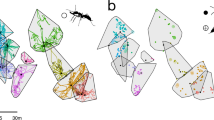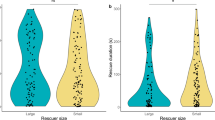Abstract
Solitary foragers can balance demands for food and safety by varying their relative use of foraging patches and their level of vigilance. Here, we investigate whether colonies of the ant, Formica perpilosa, can balance these demands by dividing labor among workers. We show that foragers collecting nectar in vegetation near their nest are smaller than are those collecting nectar at sites away from the nest. We then use performance tests to show that smaller workers are more likely to succumb to attack from conspecifics but feed on nectar more efficiently than larger workers, suggesting a size-related trade-off between risk susceptibility and harvesting ability. Because foragers that travel away from the nest are probably more likely to encounter ants from neighboring colonies, this trade-off could explain the benefits of dividing foraging labor among workers. In a laboratory experiment, we show that contact with aggressive workers results in an increase in the mean size of recruits to a foraging site: this increase was not the result of more large recruits, but rather because fewer smaller ants traveled to the site. These results suggest that workers particularly susceptible to risk avoid dangerous sites, and suggest that variation in worker size can allow colonies to exploit profitably both hazardous and resource-poor patches.








Similar content being viewed by others
References
Baalen M van, Sabelis MV (1999) Nonequilibrium population dynamics of ‘ideal and free’ prey and predators. Am Nat 154:69–88
Bernstein S, Bernstein RA (1969) Relationship between foraging efficiency and the size of the head and component brain and sensory structures in the red wood ant. Brain Res 16:85–104
Beshers SN, Fewell JH (2001) Models of division of labor in social insects. Annu Rev Entomol 46:413–440
Bourke AFG, Franks NR (1995) Social evolution in ants. Princeton University Press, Princeton, N.J.
Brandão CRF (1978) Division of labor within the worker caste of Formica perpilosa Wheeler (Hymenoptera: Formicidae). Psyche 85:229–237
Brown JS (1999) Vigilance, patch use and habitat selection: foraging under predation risk. Evol Ecol Res 1:49–71
Detrain C, Pasteels JM (1992) Caste polyethism and collective defense in the ant, Pheidole pallidula: the outcome of quantitative differences in recruitment. Behav Ecol Sociobiol 29:405–412
Dukas R (2001) Effects of perceived danger on flower choice by bees. Ecol Lett 4:327–333
Feener DH Jr (1981) Competition between ant species: outcome controlled by parasitic flies. Science 214:815–817
Fewell JH (1988) Energetic and time costs of foraging in harvester ants, Pogonomyrmex occidentalis. Behav Ecol Sociobiol 22:410–408
Franks NR (1985) Reproduction, foraging efficiency and worker polymorphism in army ants. In: Hölldobler B, Lindauer M (eds) Experimental behavioral ecology and sociobiology (Fortschritte der Zoologie, no. 31). Sinauer, Sunderland, Mass., pp 91–107
Franks NR, Partridge LW (1993) Lanchester battles and the evolution of combat in ants. Anim Behav 45:197–199
Franks NR, Sendova-Franks AB, Anderson C (2001) Division of labour within teams of New World and Old World army ants. Anim Behav 62:635–642
Gordon DM, Kulig AW (1996) Founding, foraging, and fighting: colony size and the spatial distribution of harvester ant nests. Ecology 77:2393–2409
Hölldobler B, Wilson EO (1990) The ants. Harvard University Press, Cambridge, Mass.
Iwasa Y (1982) Vertical migration of zooplankton: a game between predator and prey. Am Nat 120:171–180
Julian GE, Cahan S (1999) Undertaking specialization in the desert leaf-cutter ant Acromyrmex versicolor. Anim Behav 58:437–442
Lighton JRB, Bartholomew GA, Feener DH Jr (1987) Energetics of locomotion and load carriage and a model of the energy cost of foraging in the leaf-cutting ant Atta columbica Guér. Physiol Zool 60:524–537
Lighton JRB, Quinlan MC, Feener DH Jr (1994) Is bigger better? Water balance in the polymorphic desert harvester ant Messor pergandei. Physiol Entomol 19:325–334
Lima SL (1998) Nonlethal effects in the ecology of predator–prey interactions. BioScience 48:25–34
Lima SL (2002) Putting predators back into behavioral predator-prey interactions. Trends Ecol Evol 17:70–75
Lima SL, Dill LM (1990) Behavioral decisions made under risk of predation: a review and prospectus. Can J Zool 68:619–640
Mabelis AA (1979) Wood ant wars: the relationship between aggression and predation in the red wood ant (Formica polyctena Först). Neth J Zool 29:451–620
McGlynn TP (2000) Do Lanchester’s laws of combat describe competition in ants? Behav Ecol 11:686–690
McIver JD, Loomis C (1993) A size-distance relation in Homoptera-tending thatch ants (Formica obscuripes, Formica planipilis). Insectes Soc 40:207–218
Nonacs P (1990) Death in the distance: mortality risk as information for foraging ants. Behaviour 112:23–35
Nonacs P (2002) Patterns of energy allocation within foragers of Formica planipilis and Pogonomyrmex salinus. W N Am Nat 62:188–196
Nonacs P, Dill LM (1988) Foraging response of the ant Lasius pallitarsis to food sources with associated mortality risk. Insectes Soc 35:293–303
Nonacs P, Dill LM (1990) Mortality risk vs. food quality trade-offs in a common currency: ant patch preferences. Ecology 71:1886–1892
O’Donnell S, Jeanne RL (1995) Implications of senescence patterns for the evolution of age polyethism in social insects. Behav Ecol 6:269–273
Orr MR (1992) Parasitic flies (Diptera: Phoridae) influence foraging rhythms and caste division of labor in the leaf-cutter ant, Atta cephalotes. Behav Ecol Sociobiol 30:395–402
Oster GF, Wilson EO (1978) Caste and ecology in the social insects. Princeton University Press, Princeton, N.J.
Pankiw T, Page RE Jr (2000) Response thresholds to sucrose predict foraging division of labor in honeybees. Behav Ecol Sociobiol 47:265–267
Passera L, Roncin E, Kaufmann B, Keller L (1996) Increased soldier production in ant colonies exposed to intraspecific competition. Nature 379:630–631
Reyes Lopez JL (1987) Optimal foraging in seed-harvester ants: computer-aided simulation. Ecology 68:1630–1633
Rice WR (1989) Analyzing tables of statistical tests. Evolution 43:223–225
Rissing SW (1982) Foraging velocity of seed-harvester ants, Veromessor pergandei (Hymenoptera: Formicidae). Env Entomol 11:905–907
Rosengren R, Sundström L (1987) The foraging system of a red wood ant colony (Formica s. str.)—collecting and defending food through an extended phenotype. In: Pasteels JM, Deneuberg JL (eds) From individual to collective behavior in social insects. Birkhäuser, Basel, Switzerland, pp 117–139
Schumacher A, Whitford WG (1974) The foraging ecology of two species of Chihuahuan desert ants: Formica perpilosa and Trachymyrmex smithi neomexicanus (Hymenoptera: Formicidae). Insectes Soc 21:317–330
Tofilski A (2002) Influence of age polyethism on longevity of workers in social insects. Behav Ecol Sociobiol 51:234–237
Wilson, EO (1980) Caste and division of labor in leaf-cutter ants (Hymenoptera: Formicidae: Atta), I: The ergonomic optimization of leaf cutting. Behav Ecol Sociobiol 7:157–165
Wilson, EO (1985) The sociogenesis of insect colonies. Science 228:1489–1495
Wright PJ, Bonser R, Chukwu UO (2000) The size–distance relationship in the wood ant Formica rufa. Ecol Entomol 25:226–233
Acknowledgments
We thank David Holway, Jennifer Fewell, and the Social Insect Research Group at Arizona State University for helpful comments on the manuscript. Several anonymous reviewers also provided helpful comments. We also thank the staff at the Southwestern Research Station for assistance, and the Statistical Consulting Service at the University of Minnesota for advice. Glen Needham kindly provided use of a microbalance. The experiments comply with the current laws of the United States.
Author information
Authors and Affiliations
Corresponding author
Additional information
Communicated by L. Sundström
Rights and permissions
About this article
Cite this article
Kay, A., Rissing, S.W. Division of foraging labor in ants can mediate demands for food and safety. Behav Ecol Sociobiol 58, 165–174 (2005). https://doi.org/10.1007/s00265-005-0914-x
Received:
Revised:
Accepted:
Published:
Issue Date:
DOI: https://doi.org/10.1007/s00265-005-0914-x




